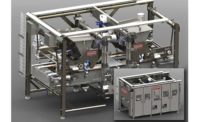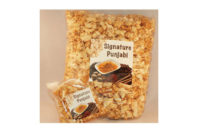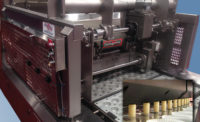Consumer demand for baked goods and snacks that are better-for-you, clean-label, gluten-free or in line with other food trends are prompting many bakers and snack manufacturers to re-examine existing products and develop new ones. Depending on the ingredients they add to or remove from formulations to achieve the results they desire, manufacturers can find themselves dealing with dough that’s thicker, stickier or otherwise different from the original recipe—and wondering whether their processing equipment will be able to handle it.
Bakery equipment manufacturers are also keeping an eye on consumer trends and working with their customers to design machines—including depositors and dividers—capable of producing today’s in-demand baked goods and snacks.
Addressing unique challenges
When it comes to the still growing gluten-free sector, Stewart Macpherson, vice president of sales & marketing, Unifiller Systems Inc., Delta, British Columbia, says the company has been very successful in adapting its depositors to handle the stickier, viscous and variable consistency of some gluten-free recipes, which require deposit nozzles with cut-off or spreading attachments.
Unifiller also invented a new single-piston valve block that provides less-restricted product flow, improved deposit accuracy and gentler handling of delicate products. According to Macpherson, the single-piston valve block also handles larger chunks while still maintaining product integrity. From a safety standpoint, it eliminates pinch points or finger traps and the need for safety guards on hoppers, and it remains operator-safe if the hopper is completely removed. All of the company’s single-piston machines—tabletop models to the 1000i series—feature the new valve block design.
Another recent Unifiller depositor development enables manufacturers to more precisely control the deposit speed on volumetric depositors. The company’s Dial In speed control lets operators set this speed to a known speed position with the turn of a single knob. All of the company’s 1000i models include this feature; it’s not included on more price-sensitive tabletop or small compact machines.
Rod Gregg, vice president, sales, Hinds-Bock Corp., Bothell, WA, says manufacturers want depositors that can handle thick, sticky batters. “The cut-off must be clean, which can be a problem for many depositor manufacturers,” he explains. “Hinds-Bock has a whole family of specialized positive cut-off spouts designed specifically for handling these types of batters.”
Several years ago, the company introduced high-speed, servo-driven batter depositors that can be used to make muffins, cupcakes, brownies and round, loaf and sheet cakes. According to Gregg, the machines are quieter than conventional air-powered machines and provide easy automatic adjustment for both batter-depositing speed and volume. They can also be fine-tuned to lay down a wide, thin deposit of batter, an application air-powered machines can have difficulty performing.
Bruce Campbell, vice president global product technology, AMF Bakery Systems, Richmond, VA, says the company is evolving its Flex divider line to handle doughs that need to be deposited into pans. “Most gluten-free doughs can be processed with this method,” he notes. “It is actually a very efficient production method.”
The new Flex divider line from AMF Bakery Systems includes BreadFlex for bread and specialty dough; HBDFlex for bread, buns, rolls, tortillas, English muffins and specialty dough; MuffinFlex for English muffins; and RollFlex for rolls.
“Our Flex dividers have a built-in dough developer for generating just the right grain structure,” says Campbell. “This drastically lowers the cost of capital acquisition, as well as significantly lowers maintenance, sanitation and changeover waste.” He adds that the line also allows bakers to make a wide variety of products on their make-up lines and at a lower overall cost.
Another benefit of Flex dividers is reduced changeover time. “On the bun and tortilla dividers, if changes in speed or port configurations are needed, they are all done through the recipe-management system with the push of a button,” Campbell explains. “No tools, plugs or adjustments are needed, and start-up weights are right on target, so the operator is free to handle other duties.”
AMF Bakery Systems recently redesigned some of its rounders and moulders, as well. Recent improvements to the frame design and rounding tunnels of the company’s AMF Bread and Bun Belt rounders allow for greater sanitary operation and flexibility. Alternate-size rounder bars available on the same rounder frame provide rounding over a wide range of sizes. Adjustable rounder bars for the company’s tortilla lines ensure a perfectly round dough shape for pressing.
All AMF moulders, including the Straight Line, Cross Grain and Tend’r Kurl, have been redesigned for simplicity and sanitation. “The total number of parts and assembly time have been reduced by almost 50 percent, which means they are simpler to operate, maintain and keep clean,” says Campbell.
Beyond consumer demand
Consumer demand for new types of baked goods and snacks aren’t the only factors prompting bakers and snack manufacturers to re-examine their make-up equipment needs. The need for quicker changeovers, equipment flexibility and reduced labor costs are also factoring into decision-making.
“The movement toward more variety means more changeovers by the bakers,” says Campbell. “Thus, a flexible make-up line is necessary to justify a new production line. AMF now combines high-efficiency core bread and bun technology with our Unison Sheeting line to offer the maximum flexibility in a production line.”
Campbell adds that sanitation, waste reduction and integrated solutions are additional important considerations for bakers and snack manufacturers when selecting a divider, rounder or other make-up equipment.
Macpherson says developing a depositor design that allows for quick and frequent product changeovers has been one of Unifiller’s most-important challenges. The resulting depositor design has, he says, the least amount of parts to clean, maintain or lose.
Gregg likewise notes that the need for quick changeovers to run different products, and easy sanitation and maintenance, are important considerations for food processors when buying depositing equipment, considerations that have factored into Hinds-Bock designs. Recently, the company has also seeing more interested in safety and ergonomic design.
“Reducing labor and consistent product appearance and uniformity are also big factors when customers look to buy a depositor,” Gregg adds. “The lack of available skilled labor continues to be a large factor, so customers continue to pursue automation in the area of depositing.”
Hinds-Bock offers a fully automated snack cake line that delivers high-speed snack cake production with minimal labor. Features include automatic tray placement, accurate and targeted release agent application and accurate batter depositing. The system can also be used to target moist streusel or dry toppings onto snack cake batter and spread the toppings onto the cake. Easy setup, operation, sanitation and maintenance guarantees the system will deliver a high level of accuracy for years to come, according to the company.










